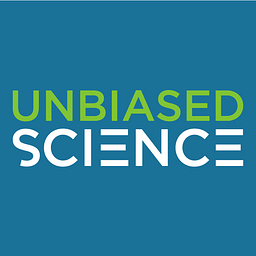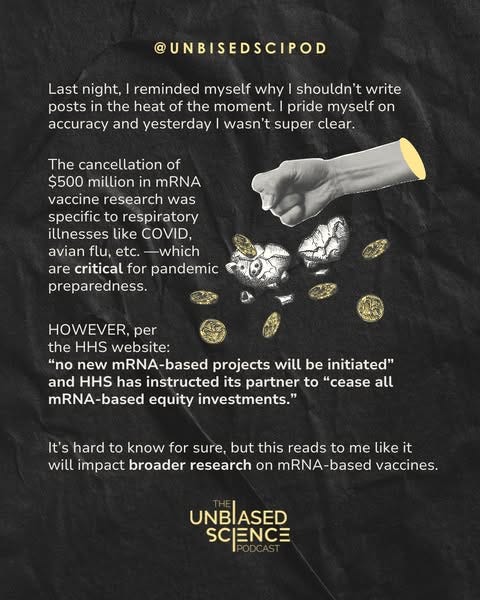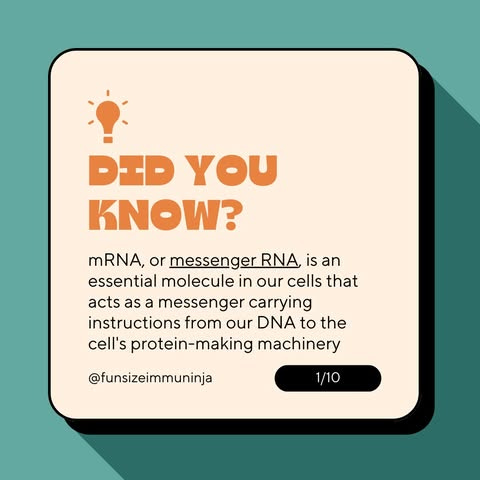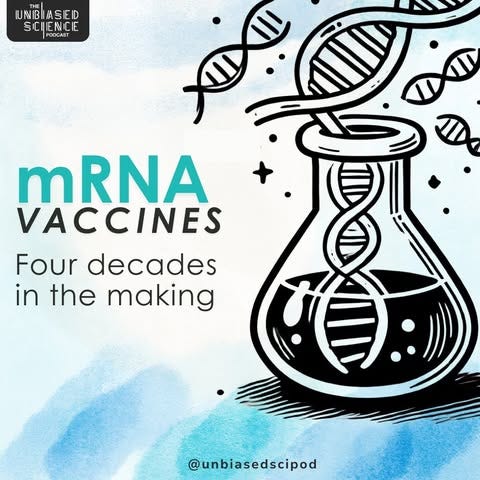When Science Becomes the Enemy
Description
We messaged each other on Tuesday with just three words: "Did you see?" We both knew what the other meant. After years of explaining to friends and family that yes, mRNA has always been in their bodies, and no, it doesn't change your DNA, we watched as nearly half a billion dollars in research funding vanished with the stroke of a pen (rather, a ‘key’).
While the cuts specifically targeted COVID and flu vaccine development, the ripple effects are devastating: the same platform technology, the same research infrastructure, and the same scientific expertise that drives all mRNA innovation are being gutted. The technology that could cure pancreatic cancer, treat cystic fibrosis, and stop the next pandemic was being dismantled based on misconceptions we've been fighting for years.
This Substack is reader-supported. To receive new posts and support our work, consider becoming a free or paid subscriber.
Despite its scientific success, mRNA has found itself at the center of controversy and public confusion since 2020. The recent funding cuts, justified by claims that contradict overwhelming scientific evidence, represent more than a policy shift; they signal a dangerous retreat from one of modern medicine's most promising tools.
From its role in basic cellular function to its revolutionary applications in medicine, mRNA is not a threat. It's a tool of hope. Let’s discuss…
The Role of mRNA in Cellular Function and Protein Synthesis
Messenger RNA, or mRNA, is a fundamental molecule in our cells. Each cell in our body makes and uses mRNA every day to make protein. mRNA acts as a courier, carrying genetic instructions from DNA to the cell's protein-making machinery. Every day, our cells produce mRNA to ensure the right proteins are made at the right time, essential for everything from metabolism and immunity to tissue repair.
Think of DNA as a cookbook stored in the cell's nucleus. mRNA is like a recipe copied from that cookbook and delivered to the kitchen counter (the cytoplasm), where ribosomes (the chefs) read the instructions and cook up proteins.
This elegant process, the transcription of DNA into mRNA followed by translation into proteins, is known as the central dogma of molecular biology.
Harnessing Nature: The Rise of mRNA Vaccines
Understanding this natural cellular process is crucial because it reveals how scientists have ingeniously harnessed our body's own machinery for medical breakthroughs. That’s right…researchers have learned to use this natural system to develop mRNA vaccines. (If there's one message that needs better marketing, it's this: mRNA vaccines use your body's natural processes—nothing artificial about it.)
These vaccines teach our cells to produce a harmless piece of a pathogen, like the spike protein of SARS-CoV-2, which then triggers an immune response. This primes the immune system to recognize and fight the real virus if encountered out in 'the wild' (think grocery store and soccer games to schools and your place of work).
The success of mRNA vaccines against COVID-19 has ignited innovation into a new era of rapid, adaptable, and scalable vaccine development. Unlike traditional vaccines, mRNA vaccines can be designed and manufactured relatively quickly, without the need to grow pathogens (like viruses) in labs, and have revolutionized vaccine development.
mRNA Technology is a Platform for the Future
The potential of mRNA technology goes far beyond vaccines for infectious diseases. Current research spans multiple frontiers:
Cancer Immunotherapy
Researchers are developing mRNA vaccines to treat cancers by encoding tumor-associated antigens (TAAs) or tumor-specific antigens (TSAs). These antigens train the immune system to recognize and destroy cancer cells. Clinical trials are underway for melanoma, glioblastoma, breast, prostate, and pancreatic cancers. As an example, a personalized mRNA vaccine for pancreatic cancer that uses a patient's tumor mutations to train the immune system to prevent recurrence has shown incredibly promising results. Early results from a Phase I clinical trial exhibited immune responses linked to delayed cancer return, supporting the ongoing larger Phase II study.
Rare and Genetic Diseases
Researchers are exploring mRNA-based protein replacement therapies for conditions like cystic fibrosis and metabolic disorders. mRNA could be used to produce missing or defective proteins directly in patients' cells. For people with cystic fibrosis (CF), a clinical trial currently underway is testing an inhaled mRNA therapy called RCT2100 for patients who have specific genetic mutations that don't respond to current treatments. This potential therapy aims to restore the function of the cystic fibrosis transmembrane conductance regulator (CFTR) protein in the lungs, targeting the root cause of CF rather than just managing symptoms.
Autoimmune Disorders
Innovative approaches using mRNA to induce a 'do no harm' signal, or immune tolerance, to immune cells are showing promise. For example, mRNA encoding modified myelin proteins to decrease and/or prevent autoimmune attacks to the myelin sheath surrounding neurons in the brain in multiple sclerosis are under investigation in mice with the future possibility for application in humans.
Combination Vaccines
The flexibility of mRNA technology enables scientists to develop combination vaccines that can protect against multiple diseases in a single formulation. This modular approach allows for more efficient vaccine design<a href="https://pmc.ncbi.nlm.nih.gov/articles/PMC11188343/#:~:text=Currently%2C%20the%20research%20a









